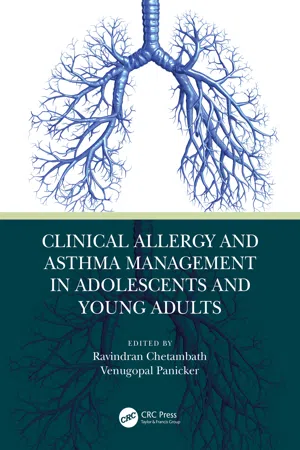Introduction
An allergic condition is a hypersensitivity disorder in which the immune system reacts to substances in the environment that are normally considered harmless. The term allergy encompasses a wide range of conditions. Allergies are the result of an inappropriate reaction to innocuous environmental proteins. It is not a disease in itself. Any substance that is recognized by the body immune system as unsuitable is an allergen. In people with an allergic tendency, the allergens are picked up by certain cells called antigen presenting cells which process them and allow them to be recognised by and to initiate the innate immune system (1). The incidence and prevalence of allergy has increased worldwide in recent decades. The precise cause of this increase is unknown but definitely reflects changes in lifestyle, in particular improvements in housing. Allergic disorders are proposed to result from a complex interplay between genetic and environmental factors. The common risk factors associated with development of allergy includes dust exposure, seasonal changes, number of hours spent outdoors, contact with animals, and so on. Young age, higher socio-economic status, and living in urban area are also factors leading to high prevalence of allergy. Food and medications are other common causes of allergy.
Epidemiology
Allergic disorders are common, and it has been estimated that 15% of the global population has some form of allergic reaction during their lifetime (2). More than 20% of the Indian population suffers from various forms of allergy (3). The prevalence of allergic reactions is increasing globally, and the cause of this is thought to be due to changes in lifestyle, especially improvements in housing. Reduction in breastfeeding has led to a high incidence of atopic eczema. Improvements in public health leading to the elimination of parasitic infections may contribute to allergy through a lack of physiological function for the IgE-mast cell axis. This has been explained by the hygiene hypothesis. Allergy is responsible for approximately 1% of all disability-adjusted life years lost worldwide. People with allergic disorders such as atopic dermatitis, allergic rhinitis, food allergy, and atopic asthma can experience acute signs and symptoms of disease within minutes of exposure to the associated allergens (4). They can also typically develop long-term changes in the affected tissues after repeated exposure to these allergens over a period of weeks to years.
Allergic diseases that have long been associated with lifestyle show an increasing prevalence in Western and Asian countries. Now efforts are made to investigate and find out the sensitization and disease patterns, which are a prerequisite to organizing adequate health care, such as diagnostic and therapeutic options and standards. Current epidemiological data from each country together with recent insights into the pathogenesis of immune reactions provide new strategies for the management of diseases such as allergic rhinitis, asthma, atopic dermatitis, mast cell-driven diseases, and drug allergy.
Understanding the pattern of allergic diseases in immigrants can provide further insight into the role of the environment. The risk of atopy increases with duration of residence, younger age at migration, or birth after migration as compared to migration after birth (5). The risk of allergy is low in people migrating from countries with lower to higher standards of living. First-generation immigrants have a lower prevalence of atopy compared to the native population, and a relatively low atopy risk has been shown in migrants moving from rural to urban areas. Lifestyle factors such as farming environment, smoking, family size, body weight, or frequency of colds significantly influenced the immunoglobulin (IgE) sensitization rate in adolescents. Early life risk factors influence the allergy risk in children. DNA methylation levels are believed to have a mediating role in the association between season of birth and allergic rhinitis. The mean methylation levels of the promoter regions of interferon (IFN-γ), were significantly high in children at six years of age with allergic rhinitis compared to those without allergic rhinitis (6). The association of high-sensitivity C-reactive protein (hs-CRP) with allergic disorders was studied, and it was found that there were no definite association between them.
The spectrum of allergens is highly diverse due to varied climate, flora, and food habits. Therefore, in order to facilitate an accurate diagnosis and to design vaccines for immunotherapy, proper identification, purification, and molecular characterization of allergy-eliciting molecules are essential. A meta-analysis found a sex difference for allergic rhinitis prevalence, with a male predominance in childhood and female predominance in adolescence worldwide except in Asia (7). A relationship between psychosocial factors and allergic or atopic diseases has been reported in several studies. The associations of psychosocial factors such as social status, depression, generalised anxiety, psychosocial stress, and type-D personality with the development of seasonal, perennial, and other allergies in adults are established in studies (8). An association of anxiety with seasonal allergies was also observed, whereas depression was associated with perennial allergies. Hence, allergic patients ideally require a psychological evaluation also. Allergic disorders showed an association with atopy, asthma, lower urinary tract infections, and irritable bowel disease.
Allergic rhinitis and allergic conjunctivitis are the most common allergic manifestations with a prevalence of 30%. Food allergy and atopic dermatitis are less frequent than respiratory allergy but are associated ...
